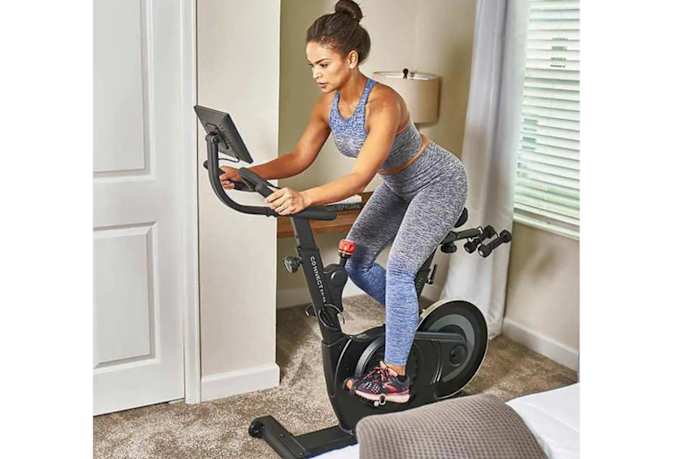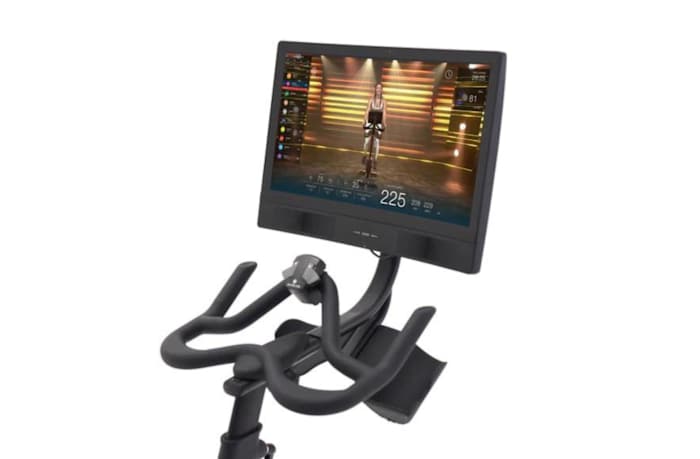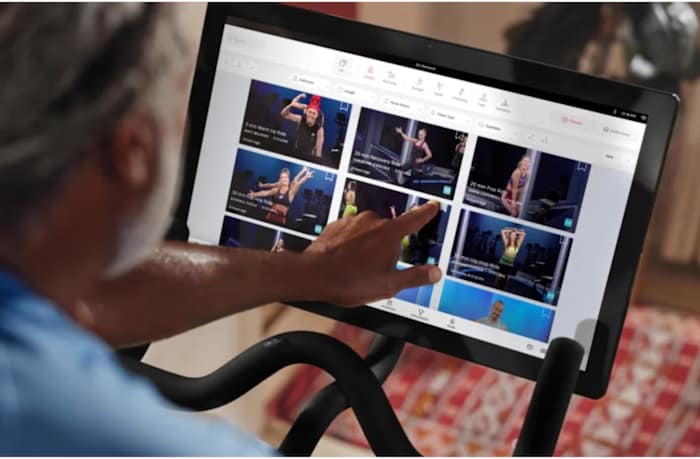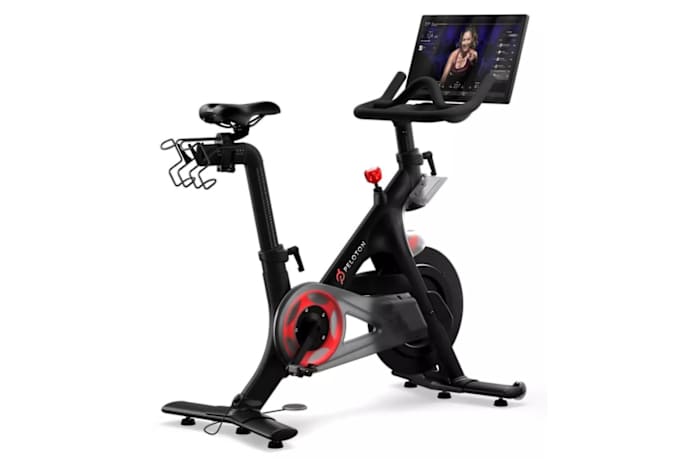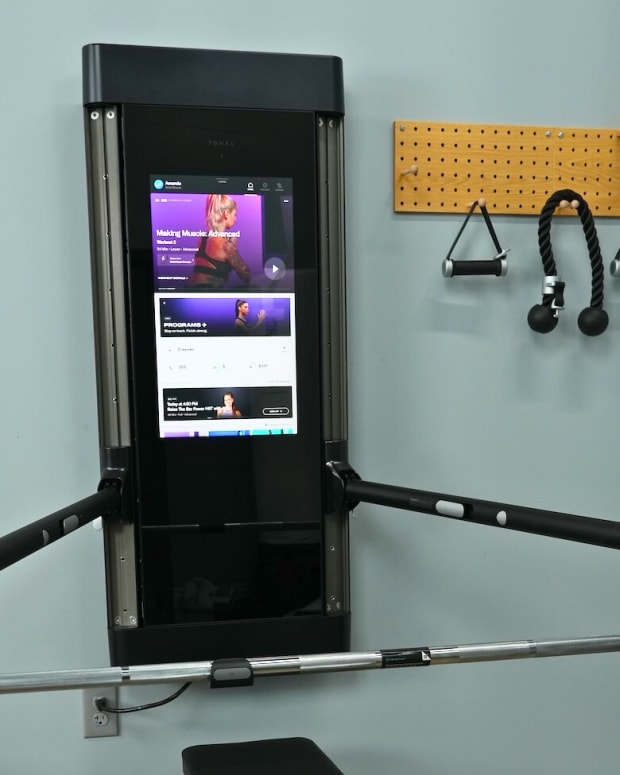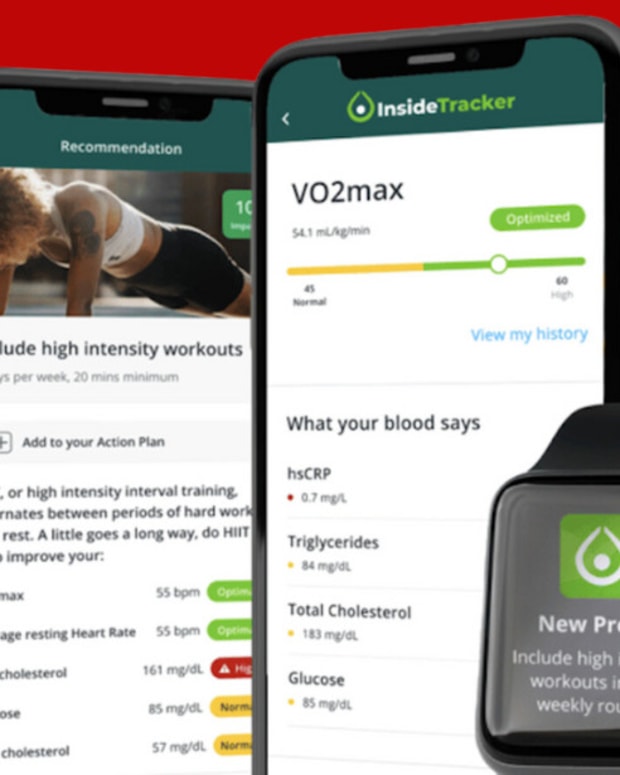The products featured in this article have been independently reviewed. When you buy something through the retail links on this page, we may earn commission at no cost to you, the reader. Sports Illustrated editorial staff are not involved in the creation of this content. Learn more here.
If connected exercise bikes were football teams, both Peloton and Echelon would be definitive Super Bowl contenders fighting to take the top spot as the best exercise bike. They have both carved out a unique niche in the world of immersive training offering people a convenient, motivating and varied way to stay fit at home. And there’s little doubt that digital training is here to stay. Research has shown that virtually-based exercise not only improves physical health but also provides social and psychological health benefits. As a result, more and more people are opting to workout at home looking at both Peloton and Echelon as options.
We can't ignore the obvious—Peloton has been the pioneer in the world of immersive training, specifically in regards to indoor cycling. Yes, they also sell treadmills but it is really the original Peloton Bike that made the brand a household name. The line of Echelon connected bikes did not make their debut until several years after Peloton broke ground. Despite not being as old or as popular as Peloton, Echelon is really giving Peloton a run for its money by making its mark as a less expensive Peloton alternative. Which begs the question, how do you know which indoor bike is the right exercise bike for you and your home gym?
There is a lot to consider when deciding between Peloton and Echelon. Budget is a major factor, but potential buyers should be aware of the key differences between the bikes and associated platforms. If you are in the market for a connected bike, let us make your life just a little bit easier.
In this article, we explore everything you need to know before making your purchase. Not only do we provide detailed bike reviews regarding key specs and features, but we also outline the specifics about their virtual training platforms. Keep reading to see how Peloton and Echelon stack up against one another.
What’s the Difference Between Echelon and Peloton?
Despite their differences, we cannot ignore the likeness between Echelon and Peloton fitness equipment. Both companies offer thousands of live and on-demand fitness classes that vary in exercise type, length, intensity and even musical genre. On both platforms, cyclists can meticulously track their fitness metrics in real-time, analyze progress and, if taking part in live classes, use the leaderboard as a source of motivation. If studio-type classes are not your jam, both Echelon and Peloton house scenic rides from across the globe. You simply need a Wifi connection to get moving.
There are two smart bikes in Peloton’s line of cardio machines: the original Peloton Bike and Peloton Bike+. While these bikes are well-made and boast some impressive specs, the bikes themselves are not especially groundbreaking. Rather, what makes them so attractive is the interactive, immersive training experience they offer as a result of their notable technology.
Both Peloton bikes come equipped with high-definition touchscreen monitors, speakers, magnetic resistance, adjustable seats and a direct connection to the Peloton App. The Peloton Bike+ features 100 levels of both magnetic and digital resistance, a swiveling and larger monitor, Auto-Adjust technology and four speakers. Comparatively, the Peloton Bike has 100 levels of magnetic and mechanical resistance, a tilting and slightly smaller screen, manual control only over resistance and two speakers. While there are some other small differences between the two, these are the most notable.
Echelon, on the other hand, has five exercise bikes in their smart connect series: GT+, EX-5, EX-5s-10, EX-5s-22 and EX-8s. Of these bikes, only the EX-5s-10, EX-5s-22 and EX-8s are equipped with touchscreen monitors while the other two models come with device holders. The Echelon bikes all offer 32 levels of magnetic resistance which are controlled manually, not quite as robust of a range as Peloton but adequate for most users. The EX-5s-10, EX-5s-22 and EX-8s do come with some sort of speaker but that differs by model. All bikes in this series have hybrid SPD-compatible/toe cage pedals as well as adjustable seats.
Perhaps the biggest difference between these brands is in their price tag. If you are on a budget, Echelon is likely more attractive as prices range from $692.99 to $1,770.99. The Peloton Bike starts at $1,445 and the Peloton Bike+ at $2,495. It is also important to note that Peloton bikes require Look Delta cycling shoes which may be an additional cost if you don’t already have a pair.
Additionally, each company offers different warranties and return policies. Echelon smart bikes come with a 30-day return policy if bought directly through the brand's site. The one year warranty is a bit disappointing and well below the industry standard.
Peloton’s warranty and return policy is slightly better. The warranty on the Peloton Bike and Peloton Bike+ is five years for the frame and one year for parts and labor. It too has a 30-day return policy wherein you receive a full refund minus shipping and handling.
How Echelon Works
Although Echelon has five models of connected stationary bikes, the experience of riding is similar on all. Even on the GT+ and EX-5, the two bikes that do not come with touchscreens, users can connect to Echelon’s digital platform by simply mounting a smart device and streaming the Echelon fit app. And while there are some notable differences between the entry-level GT+ and higher end EX-8s, the fundamental functioning of Echelon bikes do not differ all that much.
As noted earlier, all bikes feature 32 levels of digital resistance controlled by a resistance knob located on the frame. When immersed in a cycling class, users match the resistance to the instructor's directions. Since all devices and monitors flip 180 degrees, it is easy to hop off the bike and get moving on any floor workouts.
Regardless of which model you choose, they all boast a 300-pound maximum weight capacity and both adjustable seats and handlebars. As such, these bikes will accommodate most potential users. The flywheels range in weight from 15 to 38 pounds and the weight of the actual bikes range from 88 to 124 pounds.
The Echelon training platform is membership based and can be accessed directly through the connected monitors or downloaded as an app and streamed through a smart device. Echelon classes range in type from cycling and strength training to yoga, pilates and HIIT all of which are taught by world-class instructors. The workouts can be live or on-demand, or you can opt for preset scenic rides that simulate outdoor rides.
Specs:
| GT+ | EX-5 | EX-5s-10 | EX-5s-22 | EX-8s | |
|---|---|---|---|---|---|
Dimensions | 54 inches (L) x 24 inches (W) x 57 inches (H) | 58 inches (L) x 20 inches (W) x 55 inches (H) | 58 inches (L) x 21.5 inches (W) x 61 inches (H) | 58 inches (L) x 21.5 inches (W) x 61 inches (H) | 59 inches (L) x 23 inch (W) x 65 inches (H)jk,. |
Weight | 88 pounds | 106 pounds | 124 pounds | 124 pounds | 124 pounds |
Max User Weight | 300 pounds | 300 pounds | 300 pounds | 300 pounds | 300 pounds |
Resistance | 32 levels magnetic | 32 levels magnetic | 32 levels magnetic | 32 levels magnetic | 32 levels e-Drive motorized magnetic |
Display | N/A | N/A | 10 inch HD touchscreen that flips 180 degrees | 22 inch HD touchscreen that flips 180 degrees | 24 inch curved HD touchscreen, 180 degree flip |
Features | Large padded seat, device holder, hybrid SPD pedals, three color options, dumbbell rack, two water bottle holders | 180 degree flipping device holder, vented competition style, hybrid SPD pedals, dumbbell rack, two water bottle holders | Water bottle holders, hybrid SPD pedals, competition- style ventilated seat, charging ports | Water bottle holders, hybrid SPD pedals, competition- style ventilated seat, charging ports | Bluetooth resistance controller, dual SPD pedals, LED lights synced with workout metrics, dual facing speakers, dual water bottle holders, competition-style ventilated seat, 8 mp camera with privacy shield |
How Peloton Works
Both the Peloton Bike and Peloton Bike+ come with interactive monitors that provide access to their associated fitness platform. The bikes look similar to spin bikes in a traditional spin class, but they have touch screens mounted on top. With your Peloton monthly subscription, you interact with the monitor to choose from thousands of live and on-demand workouts.
Each bike is equipped with 100 micro adjustable levels of magnetic resistance. When taking a class, the resistance on the Bike+ automatically adjusts to meet the instructor cues–a feature not available on the original model. But you can still override this function on the Bike+ if the idea of someone else controlling your resistance is intimating and stick with manual adjustments using the resistance knob.
Both models can withstand user weights up to 297 pounds, yet only take up a four feet by two feet area of floor space. Paired with the adjustable seat and handlebars, the Peloton bikes accommodate most users and may be a good choice for those in smaller dwellings. The flywheel weighs 38 pounds, which contributes to the sturdy ride on these all-steel frames.
The Peloton app is home to not only cycling workouts but also nine other exercise types. Additionally, this platform has training programs, monthly challenges, live leaderboards, special programming and scenic rides. Compatible with AppleGym Kit, and any ANT+ heart rate monitor, Peloton tracks in-depth fitness metrics to monitor progress and modify workouts based on your performance. The immersive fitness experience is enhanced on the Bike+ thanks to the surround sound provided by front speakers and rear woofers. The original model has just two rear-facing speakers.
Specs:
| Peloton Bike | Peloton Bike+ | |
|---|---|---|
Dimensions | 59 inches (L) x 53 inches (H) x 23 inches (W) | 59 inches (L) x 59 inches (H) x 22 inches (W) |
Weight | 135 pounds | 140 pounds |
Max User Weight | 297 pounds | 297 pounds |
Resistance | 100 levels micro adjustable magnetic resistance with mechanical adjustment | 100 levels micro adjustable magnetic resistance with digital adjustment |
Display | 21.5 inches diagonally - tilts | 23.8 inches diagonally -360 degrees rotating |
Features | Sport series saddle, two channel rear-facing speakers, water bottle holders, dumbbell holders, 5 megapixel camera, USB port, 3.5 millimeter headphone jack, Bluetooth, Delta compatible aluminum pedals, Apple GymKit/Watch integration | Sport series saddle, 2.2 channel front-facing speakers, 2.2 channel rear-facing woofers, water bottle holders, dumbbell holders, 8 megapixel camera, USB port, 3.5 millimeter headphone jack, Bluetooth, Delta compatible aluminum pedals, Apple GymKit/Watch integration |
Echelon vs Peloton: Design
Seat
Four of the Echelon bikes are equipped with competition style ventilated seats. The GT+ has a padded saddle rather than the one found on others in the connected line of smart bikes. Both the Peloton Bike and Peloton Bike+ feature sport series saddles with a center channel, similar to saddles you may see on road bikes. Seats can be adjusted up/down as well as fore/aft on all bikes.
Pedals
In terms of functionality, the Echelon bike pedals may be considered the winner in this category. They all come with dual-sided pedals which are compatible with SPD cleat cycling shoes and, thanks to the adjustable toe cages, also work with your everyday athletic shoe. Peloton, on the other hand, only has aluminum Delta pedals. If you don’t have a pair of cycling shoes with Look Delta cleats, you will need to purchase a compatible pair.
Controls
It is safe to say that most things on the Echelon bike models that come with monitors and on the Peloton bikes are controlled via the touchscreen displays. The exception is resistance which uses a knob control on all except for the Bike+ which has the AutoAdjust feature. That said, the resistance can still be controlled by the knob.
Echelon vs Peloton: Workout Classes
Echelon's digital training platform features a variety of live and on-demand fitness classes that range from yoga and Zumba to strength and cycling. For every workout type, there are beginner, intermediate and expert options. All classes are taught by world class instructors which users describe as energetic and motivating. But, some reviews have indicated that the instructors on Echelon are not quite as detailed in their instructional cues as are the Peloton coaches.
As with the Echelon platform, Peloton offers a lot more than just cycling. The extensive library of on-demand classes include strength, boxing, running, yoga, meditation, rowing, row bootcamp, bike bootcamp and more. Peloton regularly releases new offerings of live classes, challenges and progressive series. The live classes are a fan favorite as members report the experience feels just as if you are in a real life studio. In fact, Peloton now has Peloton Studios based out of New York and London. These are state-of-the art facilities for locals who want to join. Alternatively, you can partake in the experience virtually as all classes produced on site are live streamed globally.
Echelon vs Peloton: Display and Size
There is not a ton of difference between the two brands in terms of the amount of floor real estate they’ll eat up in your home gym. The Echelon bikes range in size with the smallest measuring 54 inches long, 24 inches wide and 57 inches high and the largest stomping out a footprint of 59 inches long, 23 inches wide and 65 inches high. In comparison, the Peloton bikes require a similar four feet long by two feet wide area for set up.
On the surface, the monitors on both Peloton bikes and the upper end Echelon ones are similar. The EX-8s has a 24 inch curved screen that flips 180 degrees. While the size is on par with Peloton Bike+’s 23.8 inch screen, users have reported that the graphics, processing speed and resolution are not at the same level and could use some improvements.
Echelon vs Peloton: App
The Echelon training platform is membership based. The premier plan starts at $34.99/month for a family, $399.99 annually billed at $33.33 per month, or a two year subscription billed at $29.16 per month. If you prefer strictly off-bike workouts, there is the option for a membership to what Echelon calls FitPass which costs $11.99 per month. The FitPass has a variety of non-cycling classes such as yoga, Zumba, cardio and more, while the Premier Plan offers cycling classes, live classes, on-demand classes, scenic rides and the FitPass as well.
Echelon’s app has received some, but not a lot, of negative commentary. A few users on Amazon found the app to be glitchy, connection to be sporadic and the interface to be disorganized. But the majority of the reviews on the app are overwhelmingly positive.
The membership to Peloton is just slightly more than Echelon’s. An all access membership for up to five users is priced at $44 per month. Peloton also has the option for an app membership only which requires no equipment and is for only one individual. The middle of the road option is Peloton’s guide membership which supports five users and requires the Peloton Guide to use.
In terms of content, Peloton’s app is just as, if not more, extensive than Echelon’s. Live and on-demand classes are available as outlined above. But what is worth noting here is the community. The Peloton community of like-minded members continues to grow and athletes from across the globe join together to train, motivate and hold one another accountable which in and of itself is a huge benefit of group training. There is a definitive social aspect to the Peloton community which seems to keep bringing members back.
Echelon vs Peloton: Workout Experience
Whether you are choosing a live or on-demand class, most users find the experience on both bike brands to be engaging and motivating. With a Peloton bike you do have more options for resistance which allows for more varied intensities. Additionally, the immersive experience on Peloton is top-notch thanks to the high-tech screens and surround sound speakers (on the Bike+). The reviews speak for themselves as some have described the experience to “exceed all expectations” and to leave them “excited to do the next workout.”
Although the Echelon bikes have fewer resistance options, users still have predominantly positive things to report about their training experience. Echelon members have left reviews thanking Echelon for delivering “amazing quality products giving us budget buyers a great competitive product.” The bikes have been described as smooth, sturdy, high-quality and easy-to-use by multiple users who left feedback both on Amazon and the Echelon website.
Related Post: Peloton Tread vs NordicTrack Treadmills
Echelon vs Peloton: FAQs
Do Echelon and Peloton have scenic rides?
Yes, both Echelon and Peloton have scenic rides available on their digital platform. You can not, however, create your own route on either one.
Can you watch TV on Echelon and Peloton?
According to Peloton product specialists, you cannot watch TV on any of the Peloton bikes. Google may return different results, but the answer straight from the source is no.
Echelon product experts also stated that Echelon monitors cannot be used with other software such as YouTube or Netflix. If you purchase the model without a screen then you can watch tv through whatever smart device you mount.
Do Echelon and Peloton have a monthly fee?
To use the virtual training platforms for both Echelon and Peloton, there is a monthly fee.
Do Echelon and Peloton bikes work without a subscription?
Yes, both Echelon and Peloton bikes work without subscriptions but the use is limited. Without a Peloton membership, the bikes have only three pre-selected 30 minute classes and a Just Ride feature which will show the metrics while riding but will not track them to your rider profile. For Echelon bikes you simply select freestyle rides but there are no preset workout options.
Final Thoughts
Both Echelon and Peloton bikes offer cyclists a convenient, engaging and varied way to stay fit at home. The similarities between the two certainly outweigh the differences however, that does not make choosing one over the other an easy decision. Determining which exercise bike is the best one for your fitness needs really comes down to a few key things with the biggest likely being budget. Those looking to keep costs down may find Echelon bikes the more attractive of the two. However, If you prioritize a sense of community and top-of-the-line technology over anything else, Peloton might be a better choice for you. Either way, you’ll be equipping your home space with a quality cardio machine.
Prices are accurate and items in stock as of publish time.


